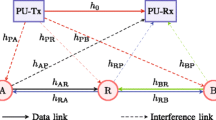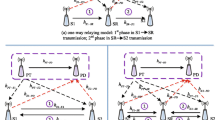Abstract
In this paper, considering the interferences from primary transmitter to secondary receiver and from secondary transmitter to primary receiver, we derive the upper and lower bounds of outage probability for underlay cognitive opportunistic multi-relay networks. Theoretical and simulation results show the upper and lower bounds converge to the exact outage probability at high interference-to-noise (INR) region. Because the interference from primary transmitter to secondary receiver is considered, an outage floor at high signal-to-noise ratio (SNR) occurs when INR increases proportionally with SNR.





Similar content being viewed by others
References
Zhao, Q., & Sadler, B. M. (2007). A survey of dynamic spectrum access. IEEE Signal Processing Magazine, 24(3), 79–89.
Li, D. (2012). Joint power and rate control combined with adaptive modulation in cognitive radio networks. Wireless Personal Communications, 63(3), 0929–6212.
Laneman, J. N., Tse, D. N. C., & Wornell, G. W. (2004). Cooperative diversity in wireless networks: Efficient protocols and outage behavior. IEEE Transactions on Information Theory, 50(12), 3062–3080.
Huang, G., Luo, L., Zhang, G., Yang, P., Tang, D., & Qin, J. (2012). QoS-driven jointly optimal subcarrier pairing and power allocation for decode-and-forward OFDM relay systems. Wireless Personal Communications, 1–22. doi: 10.1007/s11277-012-0894-x (published online).
Zhang, Q., Jia, J., & Zhang, J. (2009). Cooperative relay to improve diversity in cognitive radio networks. IEEE Communications Magazine, 47(2), 111–117.
Farraj, A. K., & Hammad, E. M. (2012). Impact of quality of service constraints on the performance of spectrum sharing cognitive users. Wireless Personal Communications, 1–16. doi: 10.1007/s11277-012-0606-6 (published online).
Luo, L., Zhang, P., Zhang, G., & Qin, J. (2011). Outage performance for cognitive relay networks with underlay spectrum sharing. IEEE Communications Letters, 15(7), 710–712.
Yan, Z., Zhang, X., & Wang, W. (2011). Exact outage performance of cognitive relay networks with maximum transmit power limits. IEEE Communications Letters, 15(12), 1317–1319.
Xia, M., & Aissa, S. (2012). Cooperative AF relaying in spectrum-sharing systems: Performance analysis under average interference power constraints and Nakagami-m fading. IEEE Transactions on Communications, 60(6), 1523–1533.
Duong, T. Q., da Costa, D., Elkashlan, M., & Bao, V. N. Q. (2012). Cognitive amplify-and-forward relay networks over Nakagami-m fading. IEEE Transactions on Vehicular Technology, 61(5), 2368–2374.
Yang, L., Alouini, M. S., & Qaraqe, K. (2012). On the performance of spectrum sharing systems with two-way relaying and multiuser diversity. IEEE Communications Letters, 16(8), 1240–1243.
Duong, T. Q., Bao, V. N. Q., Tran, H., Alexandropoulos, G. C., & Zepernick, H. J. (2012). Effect of primary network on performance of spectrum sharing AF relaying. IET Electronics Letters, 48(1), 25–27.
Yang, P., Luo, L., & Qin, J. (2012). Outage performance of cognitive relay networks with interference from primary user. IEEE Communications Letters, 16(10), 1695–1698.
Bletsas, A., Khisti, A., Reed, D. P., & Lippman, A. (2006). A simple cooperative diversity method based on network path selection. IEEE Journal on Selected Areas in Communications, 24(3), 659–672.
Bletsas, A., Shin, H., & Win, M. Z. (2007). Cooperative communications with outage-optimal opportunistic relaying. IEEE Transactions on Wireless Communications, 6(9), 3450–3460.
Win, M. Z., & Winters, J. H. (2001). Virtual branch analysis of symbol error probability for hybrid selection/maximal-ratio combining in Rayleigh fading. IEEE Transactions on Wireless Communications, 49(11), 1926–1934.
Al-Karaki, J. N., & Kamal, A. E. (2004). Routing techniques in wireless sensor networks: A survey. IEEE Wireless Communications, 11(6), 6–28.
Gradshteyn, I. S., & Ryzhik, I. M. (2007). Table of integrals, series, and products (7th ed). London: Academic.
Heinzelman, W. B., Chandrakasan, A. P., & Balakrishnan, H. (2002). An application-specific protocol architecture for wireless microsensor networks. IEEE Transactions on Wireless Communications, 1(4), 660–670.
Rudin, W. (1964). Principles of mathematical analysis (2nd ed.). New York: McGraw-Hill.
Acknowledgments
This work was supported by the National Natural Science Foundation of China (61173148, 61102070, and 61202498), the Industry-University-Research Project of Guangdong Province and the Ministry of Education, China (2011B090400581), the Natural Science Foundation of Guangdong Province (S2011040004135), the Scientific and Technological Project of Guangzhou City (12C42051578 and 11A11060133), and Guangxi Natural Science Foundation (2012GXNSFBA053162).
Author information
Authors and Affiliations
Corresponding author
Appendices
Appendix 1: Proof of Lemma 4
Note that \(I_4\) in (10) can be rewritten as
where
and \(\varOmega _1=\{\gamma /\gamma _Q \le y < \infty , \text{ ABDE }\}\). It is noted that \(0 \le \psi (x,y,z)<\infty \) and \(\psi (x,y,z)\) is a continuous function. According to additivity of integration on intervals [20, Theorem 6.12], the integral \(\int \!\!\int \!\!\int _{\varOmega _1}\psi (x,y,z)dxdydz\) increases with the increase of the area of \(\varOmega _1\) when \(\varOmega _1\in \varOmega =\{ 0 \le x,y,z<\infty \}\). Thus, by enlarging the integration region from \(\varOmega _1\) to \(\varOmega _2=\{\gamma /\gamma _Q \le y < \infty , \text{ AOE }\}\) shown in Fig. 2 and interchanging the order of integration, \(I_4\) is upper bounded by
Integrating with respect to \(x,\, \varphi \) is expressed as
where the correlation between \(Y\) and \(V\) is decoupled due to the integration regions enlarging. Substituting (4) and (25) into (24), \(I_4\) is expressed as
where
in which \(a_2=\frac{\lambda _{cd}\gamma }{\lambda _{sd}\gamma _{th}\gamma _{I}}\) and \(b_2=\frac{\lambda _{cr}\gamma }{\lambda _{sr}\gamma _{th}\gamma _{I}}\). Using Lemma 3, \(J_1\) can be expressed as
Using the binomial theorem, \(J_2\) is given as
By invoking Lemma 2, \(J_2\) can be obtained as
Substituting (29) and (31) into (26), the upper bound of \(I_4\) is obtained.
Furthermore, by shrinking the integration region of \(I_4\) to \(\varOmega _3=\{\gamma /\gamma _Q \le y < \infty , \text{ ABCDE }\}\), \(I_4\) is lower bounded by
where
Following the derivation of \(I_4^{\text{ UB }}\), we obtain \(O_1=O_3 \cdot O_4\) and \(O_2=O_5 \cdot J_2\), where
Substituting (35)-(37) into (32), the lower bound of \(I_4\) is obtained.
Appendix 2: Proof of Theorem 1
From (16) and (17), the outage gap between the lower and upper bounds is formulated as
It is noted that \(\varOmega _2-\varOmega _3=\{\gamma /\gamma _Q \le y < \infty , \text{ BODC }\}\) and interchanging the order of integration, \(\varDelta I_4\) can be expressed as
Integrating with respect to \(x,\, \chi \) is expressed as
When \(\gamma \) and \(\gamma _{Q}\) are fixed, \(\gamma _I \rightarrow \infty \), using the Taylor expansion, \(\chi \) is approximated as
Substituting (41) into (39), we obtain
which implies \(\mathop {\lim }\limits _{\gamma _I \rightarrow \infty } \left( P_{out}^{\text{ UB }}-P_{out}^{\text{ LB }} \right) =0\). When \(\rho =\gamma /\gamma _{I}\) and \(\rho _Q=\gamma _{Q}/\gamma _I\) are fixed, the similar result can be obtained.
Rights and permissions
About this article
Cite this article
Yang, P., Zhang, Q., Luo, L. et al. Outage Performance of Underlay Cognitive Opportunistic Multi-relay Networks in the Presence of Interference from Primary User. Wireless Pers Commun 74, 343–358 (2014). https://doi.org/10.1007/s11277-013-1288-4
Published:
Issue Date:
DOI: https://doi.org/10.1007/s11277-013-1288-4




